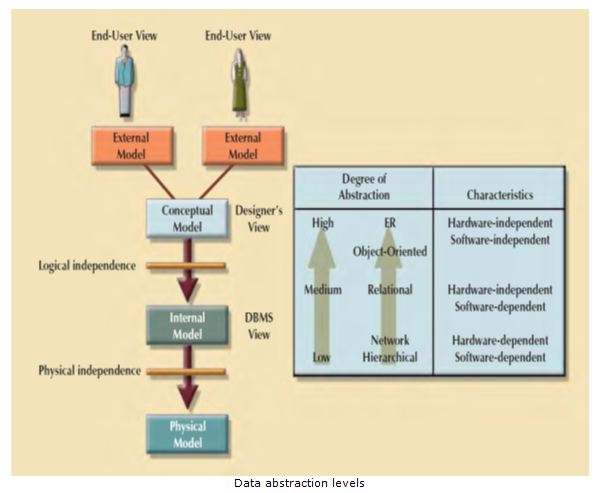Degrees of Data Abstraction in DBMS
The database designer starts with an abstract view of the overall data environment and adds details as the design comes closer to implementation.
Data abstraction in DBMS can also be very helpful in integrating multiple (and sometimes conflicting) views of data as seen at different levels of an organization.
The ANSI/SPARC architecture (as it is often referred to) defines three levels of data abstraction: External, Conceptual, and Internal.

Degrees of Data Abstraction in DBMS
The External Model:
The external model is the end users’ view of the data environment.
The term end users refers to people who use the application programs to manipulate the data and generate information. End users usually operate in an environment in which an application has a specific business unit focus. Companies are generally divided into several business units, such as sales, finance, and marketing.
Each business unit is subject to specific constraints and requirements, and each one uses a data subset of the overall data in the organization.
Therefore, end users working within those business units view their data subsets as separate from or external to other units within the organization.
• The use of external views representing subsets of the database has some important advantages:
• It makes it easy to identify specific data required to support each business unit’s operations.
• It makes the designer’s job easy by providing feedback about the model’s adequacy. Specifically, the model can be checked to ensure that it supports all processes as defined by their external models, as well as all operational requirements and constraints.
• It helps to ensure security constraints in the database design. Damaging an entire database is more difficult when each business unit works with only a subset of data.
• It makes application program development much simpler.
The Conceptual Model:
Having identified the external views, a conceptual model is used, graphically represented by an ERD to integrate all external views into a single view.
The conceptual model represents a global view of the entire database as viewed by the entire organization. That is, the conceptual model integrates all external views (entities, relationships, constraints, and processes) into a single global view of the data in the enterprise.
The conceptual model yields some very important advantages.
• First, it provides a relatively easily understood bird’s-eye (macro level) view of the data environment.
• Second, the conceptual model is independent of both software and hardware. Software independence means that the model does not depend on the DBMS software used to implement the model.
• Hardware independence means that the model does not depend on the hardware used in the implementation of the model. Therefore, changes in either the hardware or the DBMS software will have no effect on the database design at the conceptual level. Generally, the term logical design is used to refer to the task of creating a conceptual data model that could be implemented in any DBMS.
The Internal Model:
Once a specific DBMS has been selected, the internal model maps the conceptual model to the DBMS. The internal model is the representation of the database as “seen” by the DBMS.
In other words, the internal model requires the designer to match the conceptual model’s characteristics and constraints to those of the selected implementation model.
An internal schema depicts a specific representation of an internal model, using the database constructs supported by the chosen database.
Because the internal model depends on specific database software, it is said to be software-dependent. Therefore, a change in the DBMS software requires that the internal model be changed to fit the characteristics and requirements of the implementation database model.
The Physical Model:
The physical model operates at the lowest level of abstraction, describing the way data are saved on storage media such as disks or tapes.
The storage structures used are dependent on the software (the DBMS and the operating system) and on the type of storage devices that the computer can handle.
The precision required in the physical model’s definition demands that database designers who work at this level have a detailed knowledge of the hardware and software used to implement the database design.
As noted earlier, the physical model is dependent on the DBMS, methods of accessing files, and types of hardware storage devices supported by the operating system.
When you can change the physical model without affecting the internal model, you have physical independence. Therefore, a change in storage devices or methods and even a change in operating system will not affect the internal model.

You may also like:
Importance of the Data Models
Hierarchical Data Model
Network Data Model
Relational Database Model
Object Oriented Model
Other DBMS Questions








